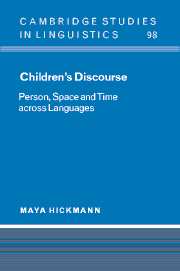Book contents
- Frontmatter
- Contents
- List of figures
- List of tables
- Preface
- List of abbreviations and conventions
- 1 Introduction
- Part I AVAILABLE THEORIES AND DATA
- 2 Theoretical issues
- 3 Cross-linguistic invariants and variations
- 4 Coherence and cohesion in discourse development
- 5 Children's marking of information status: referring expressions and clause structure
- 6 The acquisition of spatial and temporal-aspectual devices
- Part II A CROSS-LINGUISTIC STUDY OF CHILDREN'S NARRATIVES
- Appendix
- Notes
- References
- Author index
- Subject index
4 - Coherence and cohesion in discourse development
from Part I - AVAILABLE THEORIES AND DATA
Published online by Cambridge University Press: 22 September 2009
- Frontmatter
- Contents
- List of figures
- List of tables
- Preface
- List of abbreviations and conventions
- 1 Introduction
- Part I AVAILABLE THEORIES AND DATA
- 2 Theoretical issues
- 3 Cross-linguistic invariants and variations
- 4 Coherence and cohesion in discourse development
- 5 Children's marking of information status: referring expressions and clause structure
- 6 The acquisition of spatial and temporal-aspectual devices
- Part II A CROSS-LINGUISTIC STUDY OF CHILDREN'S NARRATIVES
- Appendix
- Notes
- References
- Author index
- Subject index
Summary
Before turning to the acquisition of particular linguistic devices in different domains, we first examine in this chapter developmental studies concerning general aspects of children's discourse organisation. Some of these studies invoke cognitive macrostructures to account for children's representations of event sequences (Section 4.1), others appeal to different types of social and/or cognitive skills to account for their early or later discourse abilities (Section 4.2). To summarise the discussion of this research (Section 4.3), neither set of studies has sufficiently examined children's uses of particular linguistic devices, relying on revealing but partially anecdotal evidence concerning these uses. One of the main arguments put forth in this chapter is that these devices contribute to two aspects of discourse organisation, coherence and cohesion, which have been implicitly confounded in many studies and which must be related for an adequate account of discourse development.
Macrostructures
A first type of framework has provided a general account of verbal and non-verbal knowledge about event sequences in the form of macrostructures. This research is inspired by a number of traditions across various disciplines such as psychology, linguistics, anthropology, or Artificial Intelligence (e.g. Bartlett 1964; Labov and Waletsky 1967; Propp 1979; Shank and Abelson 1977). For example, in cognitive psychology Bartlett's pioneering work on story recall served his proposal that memory is a reconstructive process that is dependent on the use of cognitive schemata or knowledge structures actively integrating incoming information.
- Type
- Chapter
- Information
- Children's DiscoursePerson, Space and Time across Languages, pp. 86 - 107Publisher: Cambridge University PressPrint publication year: 2002



